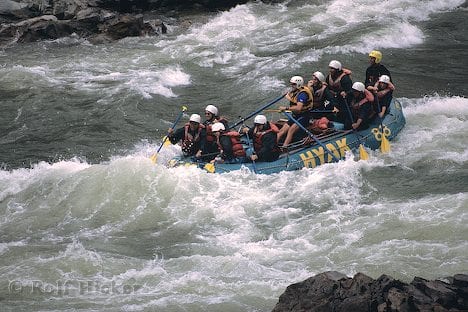River rafting in India

Today I am here to tell you about the most common water sport in india: river rafting. As most of you know rafting is an extreme sport in which you ride a inflatable raft across a river. Rafting is done in rivers because of the flow, which in not too slow and too fast.
What most of you don’t know is that a raft is made of PVC which is really tough. So tough that a raft can’t be punctured, virtually of course. There is still some risks. But then that’s the beauty of this sport. The thrill and the rush keeps you going and leaves you craving for more.
The most important part of rafting is of course the rapids. For those of you who don’t know, a rapid is a really fast flowing part of the river, which has many turbulences and in some rare cases, whirlpools. Now rapids are graded according to difficulty in navigating through them. There are 6 grades of rapids.
Grade 1: This grade requires very low skills to navigate. Hence most recommended for amateurs. It has very small rough area which requires very less maneuvering.
Grade 2: A little bit more rough area and some rocks consists of grade 2 rapids. Some basic paddling techniques must be known to the people onboard. These rapids require some maneuvering.
Grade 3: From this grade of rapids, river rafting is called white water rafting. Not recommended for amateurs. Small waves, small drops, rocks and large rough areas consist of grade 3 rapids. Significant maneuvering is required.
Grade 4: This grade marks the start of professional rafting. Medium size waves, considerable drops, large rocks and large rough area. Sharp maneuvering and fast reflexes is a must for people onboard. Everyone onboard must have experience of white water rafting.
Grade 5: Large waves, Large volume, possibility of large rocks and hazards, possibility of a large drop. This grade requires precise maneuvering and advanced white water experience
Grade 6: Grade 6 rapids are considered to be effectively unnavigable on a reliably safe basis. Rafters can expect to encounter substantial whitewater, huge waves, huge rocks and hazards, and/or substantial drops that will impart severe impacts beyond the structural capacities and impact ratings of almost all rafting equipment. Traversing a Class 6 rapid has a dramatically increased likelihood of ending in serious injury or death. This grade is not recommended for anyone. As a matter of fact, those who have rode this grade and came back alive are considered lucky not skilled.
Rafting in india is very common in rishikesh. The river ganges offers a variety of rapids and great view (of course).
Some common do’s and don’ts of river rafting are:
- NEVER PANIC.
- Never raft alone.
- Carefully listen to and obey the instructor.
- Raft according to your performance level. Never lie to the instructor about your experience.
- You may want to carrya camera. If you do, ensure that its waterproof.
- Don’t put anything sharp or metallic in your pockets. If its possible, then keeps your pockets empty.
- Apply sun block beforehand.
- Don’t wear jewellery for obvious reasons.
Always keep in mind that this is a sport. So you should not pollute the playground. There have been some environmental issues with rafting. People threw away empty packets etc in the rivers causing pollution. Remember, never mess with nature because she is the ultimate punisher. You take care of her, she will take care of you.
Keep watching this space for more adventure sports in India. Do tell us what you think of the sport in India ?
Comments
0 comments

Leave a Reply